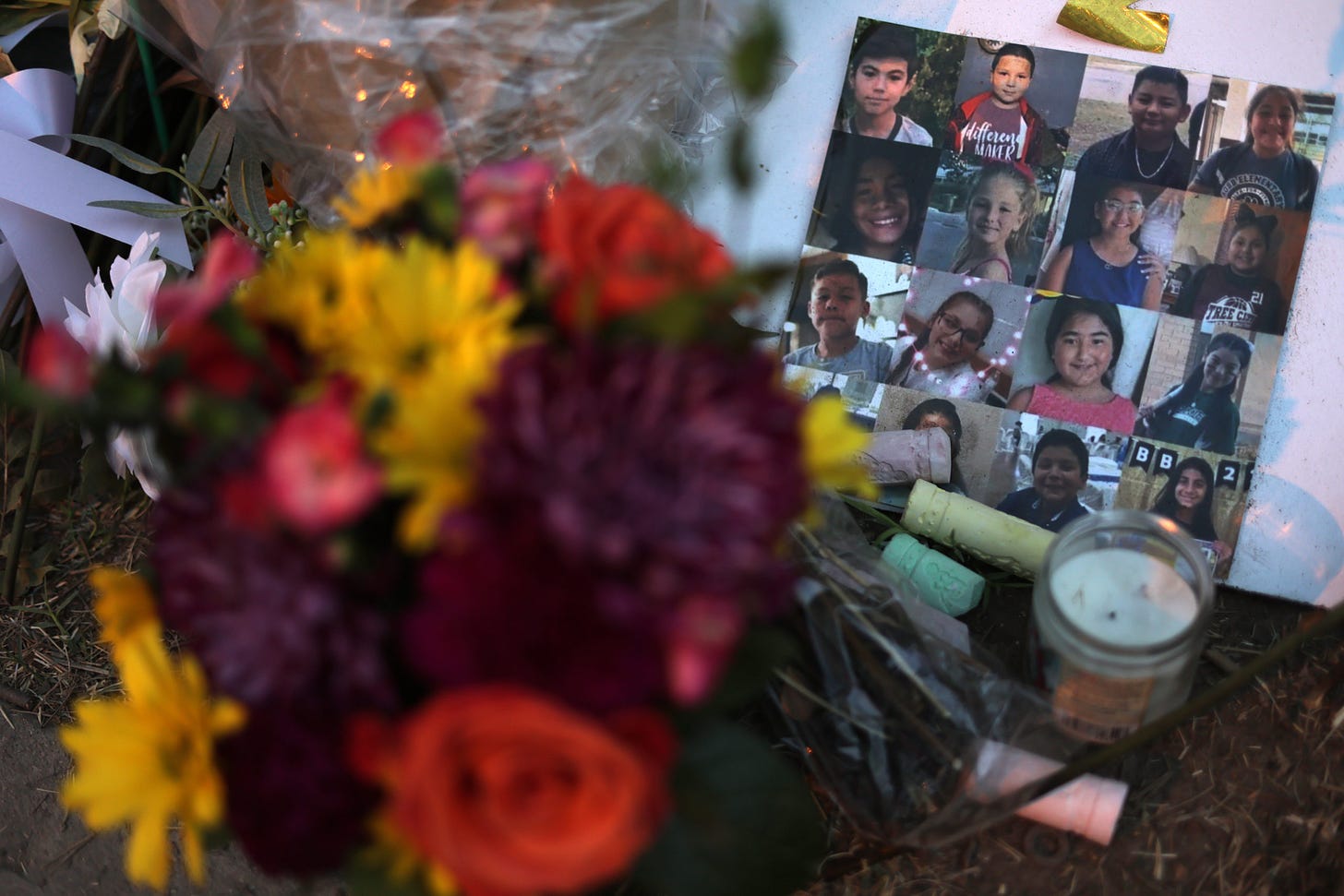

He turned in his story at the last minute, not giving us much time to read before our class discussion later that afternoon.
The story was about a student on a deadline to write a story. After fighting with his girlfriend and drinking all night, the protagonist comes into his last class in creative writing and shoots everyone in the room. Dead.
It was May 2015. Finals week at the University of Evansville, a small private liberal arts school in Southern Indiana, where I had been teaching for nearly 25 years.
I thought immediately of previous school shootings, including the one at Virginia Tech in 2007. The shooter had been a 23-year-old senior, an English major who had written about violent acts. He killed 32 people.
By noon, my office voicemail was full of messages from students calling to say they weren’t coming to class because they did not feel safe.
I called campus security to explain the situation.
Over the phone, the security guard said I could either cancel class, or he could sit outside the classroom while I taught. The guard was an overweight man in his early sixties, who, to my knowledge, never carried a gun.
I canceled class.
I called the student who wrote the story about killing a creative writing class to tell him why I was canceling our last class. He asked if he could stop by my office to talk, and I agreed to meet.
Teaching had become more and more challenging. More students had mental health problems and were on antidepressants or medications for ADHD. Every semester, I received emails giving me notice about students with emotional disorders, autism, or various forms of Asperger’s. I was spending more time in my office with students who needed to just talk.
After the Virginia Tech shooting, writing teachers were put on alert for students who wrote about harming others or violent behavior—the very stuff that students write most often about. If we were concerned, we were supposed to notify counselors or the police. But how was I to know if a violent poem or story posed a genuine threat?
As a teacher of literature and creative writing, I was accustomed to reading disturbing subject matter. In any given year, students wrote about real or fictional addictions, breakups, mass shootings, beatings, sexual assaults, and their versions of political mayhem, in those days usually inspired by Game of Thrones.
Some of my undergraduate students were writing majors. Others were there for the fun of writing or to satisfy an academic requirement. In all my years of teaching, I’d never received a threat or menacing note from a student. I had, however, received these from a fellow tenured faculty member, who was later fired for sexual harassment.
After every school shooting, right-wing politicians say the answer is arming teachers. But I couldn’t even keep track of red pens or my stapler. What if I misplaced, or worse, mishandled a loaded gun? That year in, 2015, Texas Gov. Greg Abbott signed a bill known as the “campus carry” law, which meant people licensed to carry a handgun in that state could carry a concealed handgun on university campuses. It was impossible to imagine walking into class knowing my students might be armed. Would I be in danger if I challenged them in class or gave them a grade they didn’t accept?
I also didn’t like the idea of my colleagues being armed—such as the ones who went ballistic over being denied a bigger mailbox or learning of a rival’s promotion. All of us teachers recall the shooting spree at the University of Alabama in Huntsville in 2010 when a professor armed with a Ruger P95 handgun walked into her faculty meeting and shot 12 of her colleagues because she’d been passed over for tenure.
I called Rob, my department chair, who advised me to keep the door open when the student came to meet me. Rob agreed to stay late, waiting in his office nearby, his door open. At any sign of a problem, I would sprint out of the office while Rob called 911. That was our plan. In retrospect, it sounds pathetic.
I called my husband and asked him to call and check on me in 30 minutes.
I called the security guard again who advised me to ask the student if he had any plans to harm himself or anyone else.
The guard didn’t tell me what I was supposed to do if the student answered yes.
My office was a small windowless room on the fourth floor of an old building with no elevator. My desk took up one wall and a couch took up another.
I’d recently attended a talk with a local police officer about disaster preparedness. He had handouts called “Monday Mayhem.” He told us teachers are the first ones to get shot. He said teachers need to get students out of the class first. We should tell them to run, and if we could, then we should run too. For students, fighting is your last option and running is your first: run, hide, fight. For teachers, fighting is your second option and hiding is your last: run, fight, hide.
“Do not hide under a desk,” he said. “Don’t be a victim. They don’t go after people who are fleeing. They go after people who are hunkered down.”
I had not experienced such in-class violence. But I was beginning to wonder how long my luck would last.
In addition to murdering 19 children at Robb Elementary School in Uvalde, Texas, the 18-year old shooter, armed with an assault rifle, killed Eva Mireles and Irma Garcia. The facts are still unclear. We don’t know exactly how the teachers responded when Ramos barged into their classroom and began shooting—did they try to run? Hide? Fight back? We do know that Mireles spoke on the phone with her husband, a police officer outside the school, in what would be her final minutes. And we know that Garcia’s husband, Joe Garcia, died of a heart attack two days later.
The undergraduate student who wrote the story about shooting and killing everyone in class showed up for his appointment in my office carrying a canvas backpack. He was twentysomething, had an athletic build, wore jeans and a t-shirt, and had an easy smile.
He sat on the couch and put his backpack on the floor, while I sat at my desk. I left the door open.
I had his story in my hand, but I couldn’t take my eyes off the backpack.
I asked if he’d thought about hurting students or himself.
“Look, I’d never hurt anybody.” he said. “It was just a story. But do you honestly think I’d write about it or tell you if I was planning to?”
It wasn’t quite dark yet. The building was mostly empty. I could hear water running through pipes overhead.
I told him that everyone in the class had called to say they weren’t coming because they were afraid of him. He said he felt terrible that he had scared the other students.
“It was just a story,” he said.
I asked how he was doing in his other classes. Fine, he said. He was looking forward to graduating that month, and then he looked worried.
“Will this hurt my grade?” he asked.
I held up his story.
“I can’t grade this,” I said.
He nodded, then touched his backpack, ready to leave.
The phone rang.
“You okay?” It was my husband. It had been only five minutes.
“I’m fine,” I said, looking at the student.
I was sweating through my clothes.
“You can come on up,” I said. That’s what we’d agreed for me to say, even though he was across town.
I gave the student a new deadline, a second chance to turn in something better.
“You know the rules, right?” I was referring to my “Do’s and Don’ts” handout, a list of tricks and clichés that never work in fiction writing.
“No alarm-clock beginnings,” he said.
“And?”
“Don’t kill everybody at the end.”
“Because?”
“It’s too easy.”
“So, why’d you do it?” I asked, holding up his story. I wasn’t scared anymore. I was angry.
The student still had his hand on his backpack.
“I got lazy?” he said.
Sitting across from him, it was clear to me that this was not the kind of student who’d shoot up a class. He was an athlete, a quiet kid who took writing classes he likely thought would be easy. But given the violent story he had written, and the memory of other shootings like Virginia Tech, his classmates’ fearfulness was understandable—prudent, even.
Rob knocked on my open door. “Ready for that coffee?” he asked.
“Be with you in a minute,” I said, adding that my husband was on his way.
At this point, the student must have known what was going on. He stood, picking up his backpack, and left. In a few days, he would hand in a breezy love story, pass the class, and graduate.
Right then, there was only one thing I wanted to do: go home and see my family.
I know now—I knew then—that I would not have felt any better that day if I’d had a gun. In fact, it would have made matters worse because I would have had the added consideration of possibly having to kill my student in self-defense, or of some sort of accident.
At the end of that school year I took early retirement. At the time, it wasn’t a difficult decision. University administrators, eager to cut budgets, were offering generous retirement packages to senior faculty like me. Our son was leaving for college, and I felt a motherly relief that he’d survived 9/11, anthrax, Catholic priests, and high school.
I miss teaching. I miss that particular exhaustion at the end of the day when you’ve given your best to students you love, students who sometimes respond with a poem, essay, or story that is its own miracle.
For me, giving up teaching was a kind of dying.
But at least, I’m still alive.
And after yet another school shooting, like most of us, I grieve for the dead students and the devastated parents, but I also think about the teachers, who with every new horrible episode of gun violence in our gun-crazed country, must be asking themselves if it’s worth it, if it’s fair to expect them to prepare to run, fight, hide, or even to carry a weapon to teach.
The answer is no. It’s not fair.









